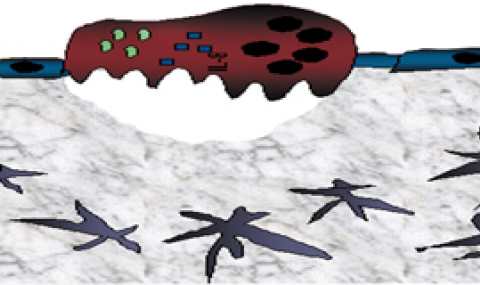The mechanisms of hematopoietic progenitor cell egress and clinical mobilization are not fully understood. Herein, we report that in vivo desensitization of sphingosine-1-phosphate (S1P) receptors by FTY720 as well as disruption of S1P gradient towards the blood, reduced steady state egress of immature progenitors and primitive stem cells via inhibition of SDF-1 release.
Administration of AMD3100 or G-CSF to mice with deficiencies in either S1P production or its receptor S1P1, or pre-treated with FTY720, also resulted in reduced stem and progenitor cell mobilization.
Mice injected with AMD3100 or G-CSF demonstrated transient increased S1P levels in the blood mediated via mTOR signaling, as well as an elevated rate of immature progenitor expressing surface S1P1 in the bone marrow (BM).
Importantly, we found that S1P induced SDF-1 secretion from BM stromal cells including Nestin+ mesenchymal stem cells via reactive oxygen species (ROS) signaling.
Moreover, elevated ROS production by hematopoietic progenitor cells is also regulated by S1P. Our findings reveal that the S1P/S1P1 axis regulates progenitor cell egress and mobilization via activation of ROS signaling on both hematopoietic progenitors and BM stromal cells, and SDF-1 release.
The dynamic cross-talk between S1P and SDF-1 integrates bone marrow stromal cells and hematopoeitic progenitor cell motility.
[figure:center:1]


Figure 3. (a) Steady state – the gradient of S1P between the peripheral blood (PB) and the BM facilitates progenitor egress via S1P1 mediated SDF-1 release. (b) Rapid mobilization (AMD3100) – progenitor cells express elevated levels of S1P1 in the BM, which increases their mobilization via the S1P gradient towards the blood. In addition, S1P increases SDF-1 release from the BM to the PB, thus enhancing progenitor cell trafficking. (c) Prolonged mobilization (G-CSF) – S1P levels are increased in the BM and PB along with augmentation of the S1P1 expressing progenitor cells. Moreover, ROS signaling is increased by S1P and HGF on primitive stem and progenitor cells, enhancing progenitor cell motility, and on BM stromal cells, inducing SDF-1 secretion and release. All these events facilitate progenitor cell mobilization.



